Melt refuse in one furnace
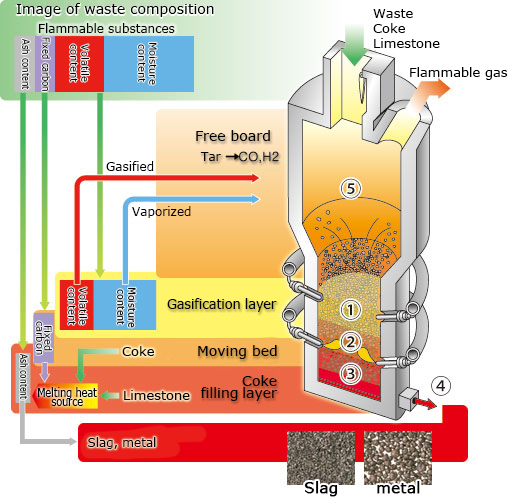
-
Gasification layer
Waste coke and limestone drops onto the top of the deposition layer close to the auxiliary tuyere.High-speed air blowing from the auxiliary tuyere and heat from the lower section of the incinerator keeps the atmosphere at approximately 700 to 900 deg C. The waste is dried and thermally decomposed – gasified.
The flammable gas produced by the thermal decomposition of the waste rises to the free board and the ash content drops to the moving bed. -
Moving bed
The ash and other contents move down onto the moving bed (②) together with the coke and limestone. Air mixed with oxygen is supplied from the main tuyere. Temperatures of approximately 1,600 to 2,000 deg C are reached through the burning of coke and fixed carbon in the waste completely melting the ash.Limestone functions as an enabler for the ash to melt and flow smoothly.
-
Coke filling layer
Under the main tuyere is a layer formed by coke that is hot but not completely burned. Slag and metal drip through this layer at approximately 1,500 to 1,700 deg C.
The slag and metal are completely melted and homogenized before they reach the bottom of the furnace and become high-quality, stable slag. -
Slag outlet
Slag and metal are continuously discharged from the slag outlet provided in the side of the furnace at approximately 1,400 to 1,500 deg C.
The discharged slag and metal drop onto the water granulation conveyor and are rapidly cooled and converted into a sand-like and granular form, respectively. -
Free board
Some of the unburnt gas produced in the gasification layer is burned by air blown from the free board nozzle. A hot reducing atmosphere of 800 to 950 deg C is maintained to improve decomposition of tar, etc.Unburnt gas will be completely burned in the secondary combustion chamber.
Safety is guaranteed by eliminating the root causes of explosions!
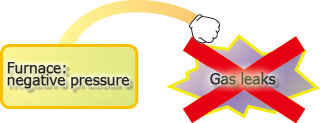
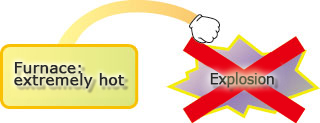
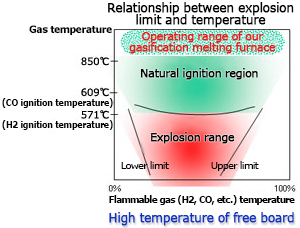

Even if air leaks into the furnace it will burn up immediately so there is minimum danger of explosions by mixed gas.
Continuous tapping technology
By reducing the deposition height of waste and maintaining heat with a heat retaining chamber, we have established continuous tapping system.
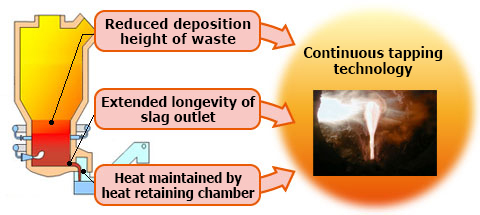
Advantages of continuous tapping
Easy to operate
Fluctuations of pressure are reduced resulting in more stable flow.
The fluctuation range of pressure is about 20% of that of intermittent tapping system.
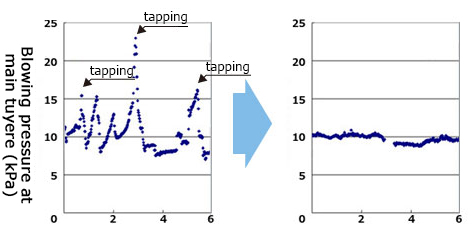
Continuous tapping (Molten substances are constantly discharged.)
Less tapping work reduces the operator workload considerably
Intermittent tapping
Molten substances are discharged every 30 to 60 minutes and requires 10 to 15 minutes work each time.
Operators must be continuously available.
Continuous tapping
All what the operators do is monitoring tapping on the ITV.
Tapping-related consumables are reduced
The significant reduction of the slag outlet opening-closing reduces related consumables to 1/10.


Even if air leaks into the furnace it will burn up immediately so there is minimum danger of explosions by mixed gas.
Features by the use of coke
Safe slag can be produced
Using coke creates an atmosphere free of oxygen. Consequently, heavy metals such as lead are vaporized and slag contains few heavy metals. The quality of the slag can be kept stable without impact of other metals in waste.
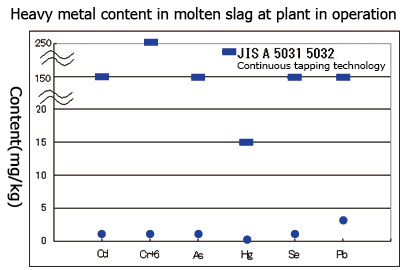

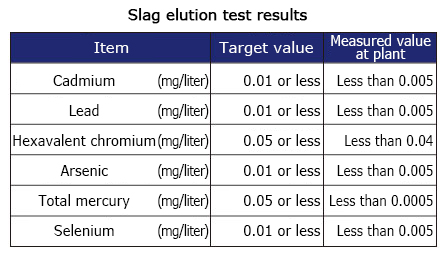
All the waste is melted.
Using coke makes the furnace capable of melting waste stably regardless of its different properties because the high heat value. There is no need to remove substances not fit for burning by means of pretreatment. The furnace is also capable of handling various kinds of waste.
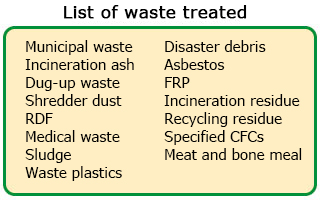
Chromium-free refractory materials
The use of coke can make the area for melting waste an oxygen free atmosphere. Therefore, it’s possible to use SiC-based refractory material to extend the longevity of the refractory. As no materials containing Cr are discharged or discarded there is no fear of hexavalent chromium discharge.
Reduced CO2 emissions.
We have developed technology that can use bio-coke in place of coke to reduce CO2 emissions.
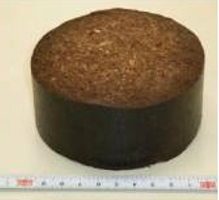
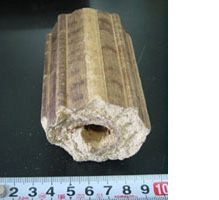
Bio-coke is made without carbonizing biomass feedstock and is efficient and environmentally friendly.
System flow
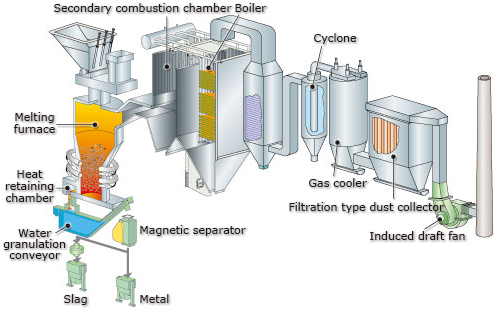
Regeneration of final disposal sites
Disposal sites can be dug up and regenerated.
Only fly ash requires final disposal.

